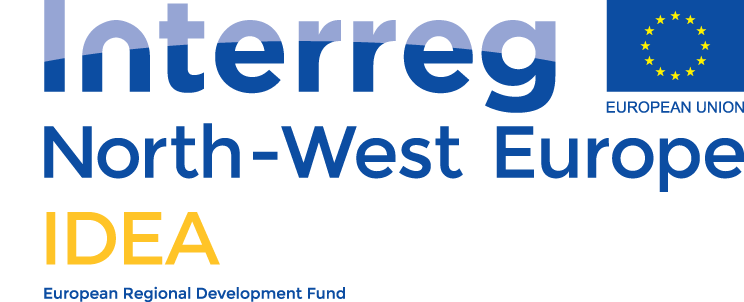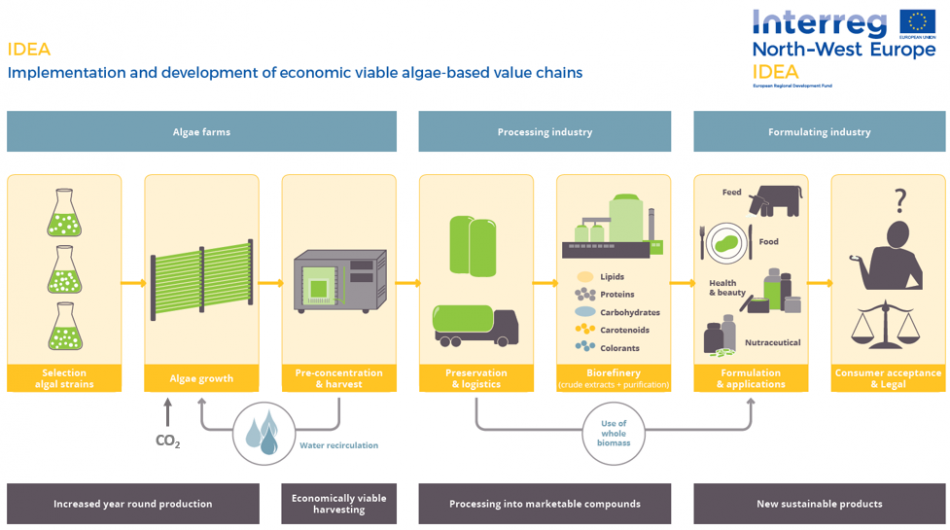More than ever, we are looking for alternatives to fossil raw materials. Not only because they are very damaging to the climate, but also because the events of the last few years have brought us face to face with the fact that we must strive to be as independent as possible by providing our own sustainable sources of healthy food, feed and chemicals. Algae have an almost inexhaustible potential. Belgium, Germany, France, the Netherlands, Ireland and the UK have united in IDEA, a project that in recent years has studied the potential of microalgae in North-West Europe. Flemish knowledge centre VITO is leading this project and is now drawing its conclusions.
May is algae month
Mol - The fact that May has been declared algae month should come as no surprise. It is quite recent that scientists have become aware of the potential of microalgae. Ninety per cent of organic chemicals are now fossil, and 70 per cent of proteins are imported. Micro-algae can offer a solution here. After all, they are also comfortable in our climate, can be harvested all year round and are a sustainable alternative to fossil fuels. Moreover, they can be used in the production of cosmetics, food and feed and in pharmaceuticals.
Growing algae in our climate is perfectly possible
Contrary to popular belief, algae do not need a subtropical climate. In fact, for some species, our milder climate with defined winters and summers is an advantage and they are potentially economically viable if we aim for higher value products. To make algae a success story, we need to make the whole process chain viable in our region: from algae growth, through harvesting, reuse, processing of the biomass (think biorefinery) to new marketable end products.
Mapping the value chain
The objective of IDEA (Implementation and Development of Economic viable Algae-based value chains) was to map the value chain of micro-algae. It has three parts. What do we need to produce algae biomass, what do we need to process that algae biomass into ingredients and how can we use those ingredients to produce a marketable product?
Each of these three components, in turn, consisted of a thorough analysis, ranging from the study of micro-algae species that thrive best here, over the production and harvesting of algae to the environmental impact of algae cultivation. But also the position of the manufacturer and consumer towards the use of algae and the legal framework to make all processes run smoothly were taken into account.
The consortium did not take any risks. Not only algae producers and equipment suppliers, but also logistics companies, cosmetics experts, experts in human and animal nutrition, research organisations and governments were involved.
Conclusions
First conclusion: there are a lot of algae species and many micro-algae species can be considered. It is therefore extremely important to focus on a limited number of selected species because this greatly shortens the expertise required for production and thus the time needed to make the product ready for the market.
Second conclusion: the initial focus should be on high-quality markets that require only limited quantities of algae and have relatively low entry barriers. In time, that market can broaden, but initially the focus should not be on markets that require large amounts of algae biomass. Within IDEA, there was a strong focus on bioactive ingredients for food, feed and cosmetics. For example, algae oil was extracted for cosmic applications, while the defatted fraction was used as a bioactive additive for feeds (e.g. in dog and chicken feed). In this way, an attempt was made to valorise the entire biomass.
Third conclusion: Today, algae-based value chains have not yet been established. Algae farms are being developed and there is certainly potential. But algae farmers first look for customers and applications before they increase their production. Algae processing is still a developing sector. So new companies are needed or current biomass processing companies have to broaden or shift their activities. There are already some commercial products on the market, but there is an urgent need for more types and quantities of algae-based products. After all, the most important engine of the value chain is a good product. IDEA has done its bit by creating health-promoting biscuits, dog snacks, dog food and chicken feed, among others.
The future
The possibilities of micro-algae as biomass are currently still unknown to many. This inhibits growth and expansion because algae farmers are also dependent on producers before they can expand.
The potential of micro-algae is inexhaustible, but at this moment there are still some hurdles to overcome. Among other things, the costs still have to be reduced, without endangering the quality of the algae. It must be carefully studied how this biomass will be used so that nothing is lost in the entire production process.
The scientists also argue for policy measures that discourage the import of cheap and less sustainable biomass and encourage the local production of alternative biomass.
Through a capitalisation initiative of Interreg NWE, the IDEA consortium will be able to continue working on algae value chain development in our regions until the end of 2023. Special attention will be paid to increasing the sustainability of algae cultivation through re-use of water, growth medium and the use of CO2 and nutrient side streams.



